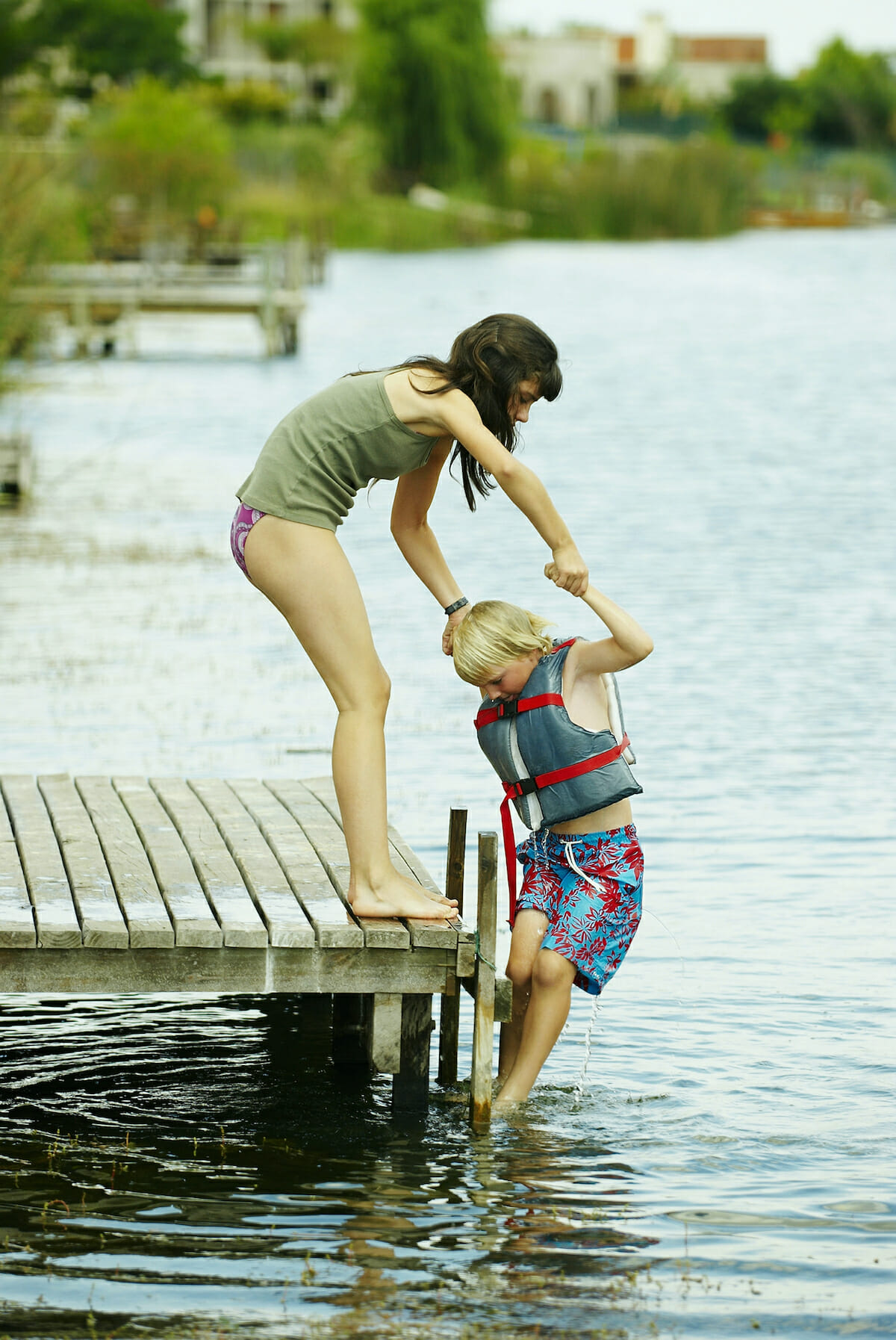Swimming in an open body of water (like a river, lake, or ocean) is different from swimming in a pool. Even kids who are good swimmers need to take care.
Parents— first, teach kids never to swim alone. Tell them that using the buddy system means there’s always someone looking out for you. When people swim together, they can help each other or go for help in an emergency.
Here are some tips based on the type of water:
At Lakes and Ponds
Don’t let kids swim without adult supervision. Lakes or ponds might be shallow near the bank, but get deep quickly away from shore.
Ponds and lakes may hide jagged rocks, broken glass, trash, and weeds and grass that could entangle a leg or arm.
Be mindful of potentially dangerous wildlife, such as snakes and alligators.
Make sure kids wear foot protection. In the water, they should wear aqua socks or water shoes.
Most boating accidents, particularly among teens, are alcohol-related. Any boat outing should include a designated driver who won’t drink. Be sure teens know about the dangers of alcohol, on and off the water.
In bad weather, they should get out of the water right away.
At Beaches
Don’t let kids swim without adult supervision, preferably where a lifeguard is on duty.
They shouldn’t swim close to piers or pilings because sudden water movements may push swimmers into them.
The beach has special dangers like currents and tides. Look for posted signs about rip currents, jellyfish warnings, surfing restrictions, and other hazards. Also ask the lifeguard about the water conditions.
Don’t allow kids to swim in large waves or undertows. Tell them never to stand with their back to the water because a sudden wave can knock them over.
Teach kids that if they’re caught in a rip current or undertow, they should swim parallel to the shore or should tread water and call for a lifeguard’s help.
The stings of jellyfish or Portuguese man-of-wars can be painful, so tell kids to watch out for them in the water and to tell an adult right away if they’re stung.
In bad weather, they should get out of the water right away. If there’s lightning, the lifeguards will close the beach.
At Water Parks
Water parks can be a lot of fun for kids, but safety rules apply there too.
Make sure the park uses qualified lifeguards.
Read all posted signs before letting your child on any rides. Many have age, height, weight, or health requirements.
Know which rides are appropriate for your child’s age and development. For instance, keep little kids in safe areas away from older kids’ splashing and roughhousing.
Water depth and strength can vary among rides and features. Wave pools can quickly go from calm to rough, putting even good swimmers in over their head.
Teach your kids to follow all rules and directions, such as walking instead of running and always going down the water slide in the right position — feet-first and face-up.
A Coast-Guard approved life jacket is a good idea too.
Boating and Jet Skis
When boating, the captain or person handling the boat should be sober, experienced, and competent. One third of boating deaths are alcohol-related. Because there are no road signs or lane markers on the water and the weather can be unpredictable, it’s important to think quickly and react well under pressure. If someone is drinking, this can be almost impossible.
Use proper-fitting, Coast Guard-approved flotation devices (life vests). Check the weight and size recommendations on the label, then have your child try it on to make sure it fits snugly. For kids younger than 5 years old, choose a vest with a strap between the legs and head support — the collar will keep the child’s head up and face out of the water. Inflatable vests and arm devices such as water wings are not effective protection against drowning.
If you allow your child or teen to use Jet Skis or personal watercraft, follow the same rules as for boating. Also check the laws in your area about the use of personal watercraft. Some states won’t allow people under a certain age to operate them; others require people to take a course or pass a test before they can ride one.
What Else Should You Know?
Water temperature is important. Enter the water slowly and make sure it feels comfortable for you and your kids. A temperature below 70°F (20°C) is cold to most swimmers. Recommended water temperatures vary depending on the activity and a swimmer’s age:
In general, 82°F–86°F (28°C–30°C) is comfortable for recreational swimming for children.
Babies are more comfortable when the water is on the warmer side of this temperature range.
Body temperature drops more quickly in water than on land. It doesn’t take long for hypothermia (when the body loses heat faster than it can make it) to set in. Get a child who’s shivering or has muscle cramps out of the water right away.
Sources: https://kidshealth.org/en/parents/water-safety-outdoorsSources: https://kidshealth.org/en/parents/water-safety-outdoors
https://www.cdc.gov/healthyschools/bam/safety/water-safety.htm
WATER WISDOM:
Floaters vs. PFDs (Personal Flotation Device or certified lifejacket)
Q: Can blow-up objects such as rafts work like life preservers?
A: Nope. Although they float, they won’t do the trick.
DO learn to swim. If you like to have a good time doing water activities, being a strong swimmer is a must.
DO take a friend along. Even though you may be a good swimmer, you never know when you may need help. Having friends around is safer and just more fun!
DO know your limits. Watch out for the “too’s” — too tired, too cold, too far from safety, too much sun, too much hard activity.
DO swim in supervised (watched) areas only and follow all signs and warnings.
DO wear a life jacket when boating, jet skiing, water skiing, rafting, or fishing.
DO stay alert to currents. They can change quickly! If you get caught in a strong current, don’t fight it. Swim parallel to the shore until you have passed through it. Near piers, jetties (lines of big rocks), small dams, and docks, the current gets unpredictable and could knock you around. If you find it hard to move around, head to shore. Learn to recognize and watch for dangerous waves and signs of rip currents — water that is a weird color, really choppy, foamy, or filled with pieces of stuff.
DO keep an eye on the weather. If you spot bad weather (dark clouds, lighting), pack up and take the fun inside.
DON’T mess around in the water. Pushing or dunking your friends can get easily out of hand.
DON’T dive into shallow water. If you don’t know how deep the water is, don’t dive.
DON’T float where you can’t swim. Keep checking to see if the water is too deep, or if you are too far away from the shore or the poolside.
LIFELINE
If you see someone struggling in the water, go get help. You can also throw out a life preserver or other object that floats, BUT DO NOT JUMP IN YOURSELF! If you jump in without anyone else around, who will help save YOU if there is a problem?











